Brightness and Contrast Ratio
For the brightness (luminance), contrast, and color accuracy tests, we depend on a hardware colorimeter and software to help calibrate the displays. We use a Monaco Optix XR (DTP-94) colorimeter and Monaco Optix XR Pro software, and we also test with ColorEyes Display Pro. Results in nearly every case have been better with Monaco Optix XR Pro, so we only report the ColorEyes Display Pro results on the monitor evaluation pages. We'll start with a look at the range of brightness and contrast at the default LCD settings while changing just the brightness level. (In some cases, it will be necessary to reduce the color levels if you want to achieve a more reasonable brightness setting of 100 or 120 nits.)
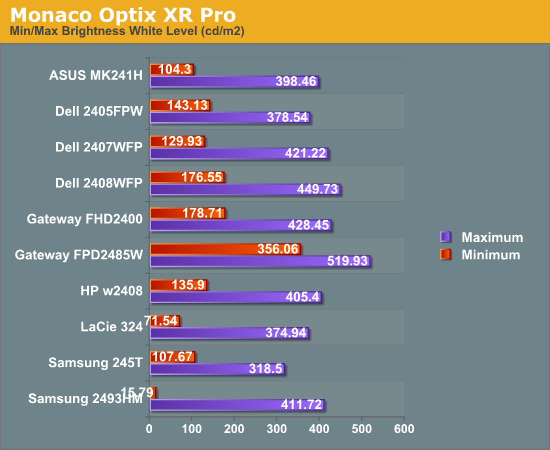
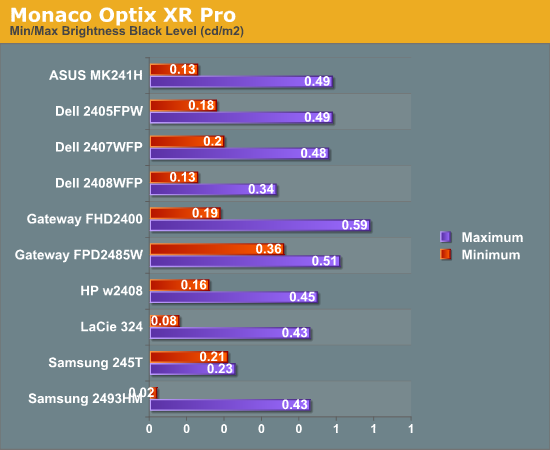
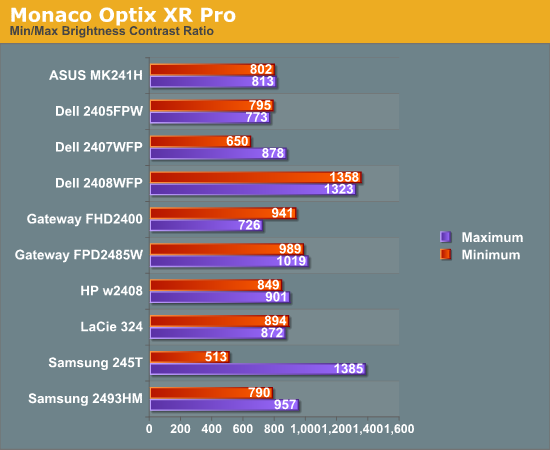
Nearly all of the LCDs have a maximum brightness level of around 400 nits, which is more than sufficient and is actually brighter than what most users prefer to use in an office environment. Minimum brightness without adjusting other settings is often above 100 nits, so it will be necessary to go in and adjust color levels as mentioned already. The Gateway FPD2485W is the prime example of this, where the default settings have a minimum brightness of 356 nits. Black levels are also reasonably consistent among the LCDs, with maximum and minimum black levels corresponding to the maximum and minimum white levels.
More important than the luminosity is the contrast ratio that is achievable at the various brightness settings. Here we begin to see some differences, with many of the LCDs following in the 800:1 ~ 900:1 range. The Dell 2408WFP and Samsung 245T stand out as having some of the highest contrast ratios, with the Dell taking the lead as it maintains the high contrast ratio even at low brightness settings. However, we should also mention that in practice the difference between 500:1 and 750:1 really isn't very significant for most users. It's only when you fall below 500:1 that colors really start to look washed out.
Color Gamut
We've already discussed color gamut of individual LCD evaluations, but it's a new addition to our LCD testing. This is something we wanted to add previously, but we lacked a good utility for generating the appropriate charts and data. We recently found out about Gamutvision, a utility developed by Imatest LLC. They were kind enough to provide us with a copy of their software, and it does exactly what we need. We compared the color profiles of all previously tested LCDs to the Adobe RGB 1998 color profile. Graphs of the individual gamut volumes are available on the evaluation pages. Below is a chart showing the percentage of the Adobe RGB 1998 gamut from the various displays.
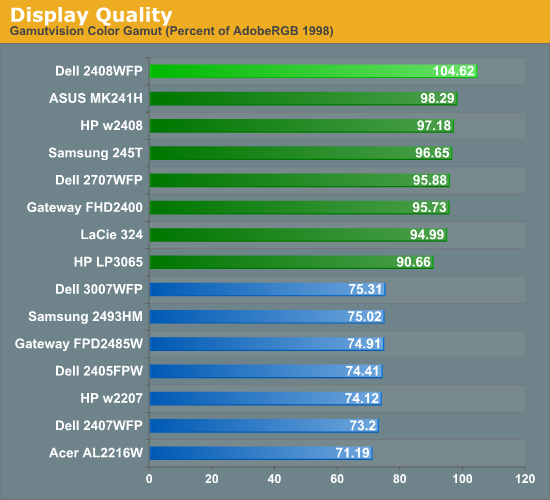
We basically end up with two tiers of quality in terms of color gamut. Filling the bottom tier are mostly older displays that have 82% NTSC color gamut backlighting. These may seem drastically inferior to the newer LCDs, but keep in mind that if you are just using the standard sRGB profile these LCDs look fine. It's only when you work in applications like Adobe Photoshop with its improved color space that you begin to notice a difference between the displays. Most of the newer displays now have ~95% Adobe RGB color gamuts, and the Dell 2408WFP actually surpasses the Adobe RGB 1998 color space. The only display in this round up that doesn't make it into the upper tier is the Samsung 2493HM.
Power Requirements
Another new test we decided to add with this roundup is a quick look at power requirements. Like the above tests, power requirements are checked at default LCD settings while varying the brightness setting. Also note that minimum power requirements are going to depend largely on how dim the backlight is at the minimum setting, so looking at the above charts it shouldn't be difficult to figure out that the Samsung 2493HM will require less power than the others when it's only putting out 16 lumens.
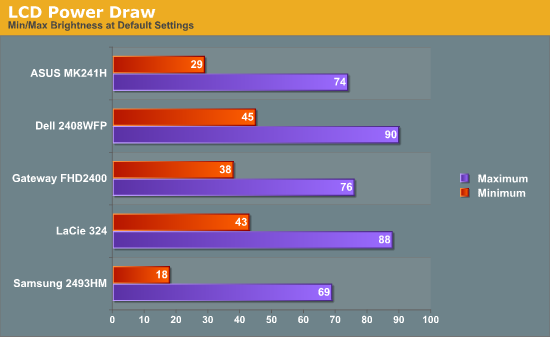
We've only begun collecting this data with this batch of LCDs, so we don't have any clear patterns established yet. However, it's interesting to note that the two S-PVA panels to seem to draw slightly more power than the three TN panels. At equivalent brightness settings, the differences in power draw are very small.










89 Comments
View All Comments
Dainas - Friday, May 2, 2008 - link
Well, it would not be as much fun as if they had done it 3 months ago. All the sub-$500 'jewels' have been dissapearing from the market. Just as well though, might as well review something that will still be easy to buy +6 months down the road.JarredWalton - Friday, May 2, 2008 - link
It shouldn't be too much of a surprise that the cheapest LCDs often have much lower quality. That being the case, most of the manufacturers of cheap LCDs are unwilling to send us review units. Hence, we end up with 24" roundups (and some upcoming 27 and 30" units as well).That said, I think more people should bite the bullet and splurge on a really nice display. I couldn't imagine running an SLI or CrossFire system without at least a 24" monitor, and having upgraded to a 30" LCD 18 months back I've never regretted the decision. I hope to continue to use my 30" LCD for at least another 5 years; try saying that about the rest of a PC. $500 sounds like a lot, but a good display can last through several PC upgrades.
Basilisk - Friday, May 2, 2008 - link
I have to agree with the original poster on this sub-thread. There's nothing about these four units that command my interest yet. If you're not shipped the units, I still find it surprising that you don't know folks who've bought the cheaper units -- I do -- or a store manager who might loan them. Whatever, you have your criteria, even if they edge your review towards irrelevance for me."That said, I think more people should bite the bullet and splurge on a really nice display." Well... that's been my strategy in life, but I've now retired and the economic picture has changed; others haven't the coins to spare or a need that justifies the extra bucks. I game, but nothing requiring high speed LCDs; I work with pictures, but nothing that justifies full color gamut monitors. So... what is there beyond elitism to recommend spending an extra $200-$400 for something I won't use? Some might call that an immature purchase decision, not splurging. I'd have loved to see the OfficeMax Soyo 24" monitor -- recurringly sold at $275 -- included so I'd know why NOT to buy it, or to.
Well, I'll probably skip the 24" size and make a 28" my next purchase anyway: at my age, size matters. :) The old orbs are becoming challenged using my 21" CRT and 22" WS LCD on detailed web pages.
strikeback03 - Tuesday, May 6, 2008 - link
For our lab we have bought a few of the Westinghouse 24" monitors Newegg sells for ~350 (After rebate) and for the price I'd assume they use a TN panel, but it has very good viewing angles.http://img.photobucket.com/albums/v315/strikeback0...">http://img.photobucket.com/albums/v315/strikeback0...
Have not had a chance to try color calibration. Seems it's biggest problems are 1) no DVI, and over HDMI it goes to blue screen instead of sleep when the signal is cut; and 2) the controls for the OSD are awful, they are on the side of the monitor so you have to try and look at their tiny labels and look around at the screen to do anything.
Dainas - Thursday, May 1, 2008 - link
Well its partly bullshit, there is a lolair MVA (different take on PVA) that has zero input lag and is lighting fast even among TNs.I can assure you of one thing, the lag in the PVA 2408WFP and LaCie is however definitely not due to the panel. Just as the 3008WFP IPS is as slow as mud next to the 3007WFP IPS due to its built in scalar. But Dell panels were never fast and I'm sure a PVA could be made as fast as the fastest MVAs, which are as fast as TNs as any sane gamer could be concerned.
Dainas - Thursday, May 1, 2008 - link
No edit function, ugh.JarredWalton - Friday, May 2, 2008 - link
I'm not at all sure that PVA can be made as fast as TN. If it can, then why do the Gateway LCDs behave so differently? The interface is practically the same and they both use Faroudja video processors. Why would Gateway use one scaler on their S-PVA and a different one on the TN - particularly if the TN scaler appears better?I don't doubt that they can reduce the lag, but you'll notice out of nine LCDs five have lag of 18ms or more and four have virtually no lag; the four without lag are TN and the five with lag are S-PVA. The circumstantial evidence is pretty significant.
Pirks - Thursday, May 1, 2008 - link
http://www.newegg.com/Product/Product.aspx?Item=N8...">http://www.newegg.com/Product/Product.aspx?Item=N8...Dying to see this reviewed!
Puhleeeasseee with sugar on top
Okay? :D
timmiser - Monday, May 5, 2008 - link
This is my monitor I've been using for the past 6 months and I absolutely love it. I bought mine at Costco.com for the same price that most of those 24" were selling for at the time. One thing about is the fact that is has the same resolution as the 24" screens so everything is a bit larger but to me, that is a good thing. I had one 19" Hanns-G monitor prior to this and can agree on the cheapness but this one I feel is of very high quality and no complaints yet.Googer - Friday, May 2, 2008 - link
I have read multiple HANS-G monitor reviews from other hardware sites in the past and the consensus is that HANS-G monitors are cheaply made to match the cheap price tag, typically resulting in a poor review.